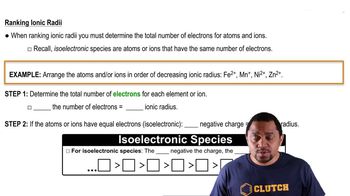Here are the essential concepts you must grasp in order to answer the question correctly.
Periodic Trends
Periodic trends refer to predictable patterns in the properties of elements as you move across or down the periodic table. Key trends include atomic radius, ionization energy, and electronegativity. Understanding these trends helps in comparing elements in the same group or period, such as the halogens and chalcogens, and predicting their behavior in chemical reactions.
Recommended video:
Atomic and Ionic Radii
Atomic radius is the distance from the nucleus to the outermost electron shell, while ionic radius refers to the size of an ion in a crystal lattice. Generally, atomic and ionic radii increase down a group due to the addition of electron shells, and decrease across a period due to increased nuclear charge. This concept is crucial for comparing the sizes of halogens and chalcogens.
Recommended video:
Ionization Energy
Ionization energy is the energy required to remove an electron from an atom or ion. It typically increases across a period due to greater nuclear charge and decreases down a group as the outer electrons are further from the nucleus. Understanding ionization energy is essential for comparing the reactivity and stability of halogens and chalcogens in their common oxidation states.
Recommended video:




